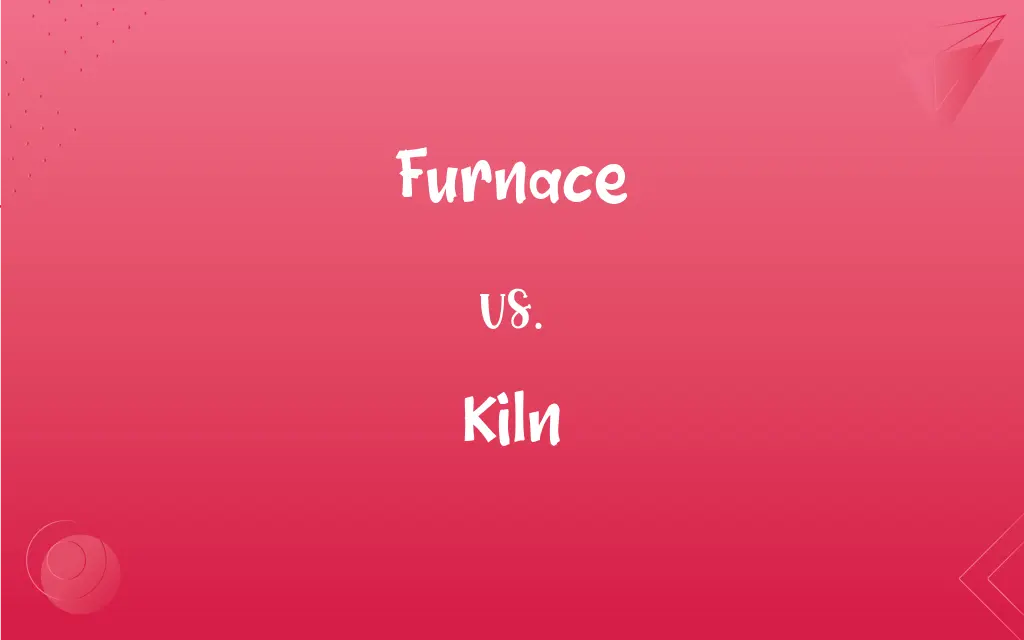Furnace vs. Kiln: What's the Difference?
By Aimie Carlson || Updated on May 29, 2024
A furnace is used for heating spaces or materials, while a kiln is primarily used for firing ceramics or bricks at high temperatures.

Key Differences
A furnace is typically designed for heating buildings or industrial processes, focusing on maintaining a consistent temperature over time. In contrast, a kiln is a specialized oven used in pottery, ceramics, and brick-making, where materials are subjected to very high temperatures for specific periods.
Furnaces can be found in residential, commercial, and industrial settings, often using fuels like gas, oil, or electricity to generate heat. Kilns, however, are predominantly found in artistic or construction environments, using electric, gas, or even wood-fired methods to achieve the necessary high temperatures for firing clay.
While a furnace is concerned with creating and sustaining heat for warming spaces or processing materials, a kiln's primary function is to harden and chemically transform materials like clay into finished ceramic products. The process in a kiln involves stages of heating and cooling, essential for achieving the desired properties in the fired materials.
The design of a furnace includes elements like burners, heat exchangers, and blowers to distribute heat effectively, whereas a kiln is structured with insulating materials and temperature controls to handle the extreme conditions needed for firing.
Furnaces are often part of a larger HVAC system, integral to maintaining indoor climate control, whereas kilns are standalone units focused entirely on the firing process, often with features like programmable temperature settings and various firing atmospheres to suit different materials and artistic techniques.
ADVERTISEMENT
Comparison Chart
Primary Use
Heating spaces or materials
Firing ceramics or bricks
Common Settings
Residential, commercial, industrial
Artistic, construction
Heat Source
Gas, oil, electricity
Electric, gas, wood-fired
Design Elements
Burners, heat exchangers, blowers
Insulating materials, temperature controls
Function
Sustaining consistent temperatures
Achieving high temperatures for transformation
ADVERTISEMENT
Furnace and Kiln Definitions
Furnace
A device used to heat buildings.
The furnace keeps the house warm during winter.
Kiln
A programmable device for controlling firing cycles.
The potter adjusted the kiln’s temperature settings.
Furnace
An apparatus for high-temperature heating in industrial processes.
The steel plant uses a blast furnace to melt iron ore.
Kiln
A special oven for firing pottery and ceramics.
The artist placed her clay sculptures in the kiln.
Furnace
An enclosed structure for smelting metals.
The blacksmith used the furnace to heat the metal.
Kiln
A heated chamber for drying materials like wood.
The lumber is dried in a kiln before use.
Furnace
A chamber for burning fuel to produce heat.
The old furnace in the basement needs replacing.
Kiln
A high-temperature furnace used in brick-making.
The factory operates a kiln for producing bricks.
Furnace
A heating system component in HVAC setups.
The HVAC technician inspected the furnace.
Kiln
An oven used in glassmaking processes.
The glassblower annealed the glass in a kiln.
Furnace
An enclosure in which energy in a nonthermal form is converted to heat, especially such an enclosure in which heat is generated by the combustion of a suitable fuel.
Kiln
Any of various ovens for hardening, burning, or drying substances such as grain, meal, or clay, especially a brick-lined oven used to bake or fire ceramics.
Furnace
An intensely hot place
The furnace of the sun.
An attic room that is a furnace in the summer.
Kiln
To process in one of these ovens.
Furnace
A severe test or trial
Endured the furnace of his friends' blame after the accident.
Kiln
An oven or furnace or a heated chamber, for the purpose of hardening, burning, calcining or drying anything; for example, firing ceramics, curing or preserving tobacco, or drying grain.
Furnace
(UK) An industrial heating device, e.g. for smelting metal or baking ceramics.
Kiln
To bake in a kiln; to fire.
When making pottery we need to allow the bisque to dry before we kiln it.
Furnace
A device that provides heat for a building; a space heater.
Kiln
A large stove or oven; a furnace of brick or stone, or a heated chamber, for the purpose of hardening, burning, or drying anything; as, a kiln for baking or hardening earthen vessels; a kiln for drying grain, meal, lumber, etc.; a kiln for calcining limestone.
Furnace
(colloquial) Any area that is excessively hot.
Kiln
A furnace for burning bricks; a brickkiln.
Furnace
(figurative) A place or time of punishment, affliction, or great trial; severe experience or discipline.
Kiln
A large oven for firing or burning or drying such things as porcelain or bricks
Furnace
To heat in a furnace.
Furnace
To exhale like a furnace.
Furnace
An inclosed place in which heat is produced by the combustion of fuel, as for reducing ores or melting metals, for warming a house, for baking pottery, etc.; as, an iron furnace; a hot-air furnace; a glass furnace; a boiler furnace, etc.
Furnace
A place or time of punishment, affiction, or great trial; severe experience or discipline.
Furnace
To throw out, or exhale, as from a furnace; also, to put into a furnace.
He furnacesThe thick sighs from him.
Furnace
An enclosed chamber in which heat is produced to heat buildings, destroy refuse, smelt or refine ores, etc.
FAQs
What is the primary use of a furnace?
A furnace is primarily used for heating spaces or materials.
Where are furnaces commonly found?
Furnaces are commonly found in residential, commercial, and industrial settings.
In what settings are kilns usually found?
Kilns are usually found in artistic or construction environments.
What is the design focus of a furnace?
The design focus of a furnace is to distribute heat effectively and maintain consistent temperatures.
What is the structural design of a kiln?
The structural design of a kiln includes insulating materials and temperature controls to handle extreme conditions.
What fuels do furnaces typically use?
Furnaces typically use gas, oil, or electricity as fuel.
What is the purpose of firing in a kiln?
The purpose of firing in a kiln is to harden and chemically transform materials like clay.
What artistic processes use kilns?
Artistic processes like pottery, ceramics, and glassmaking use kilns.
What is the main function of a kiln?
A kiln is mainly used for firing ceramics or bricks at high temperatures.
What are common heat sources for kilns?
Common heat sources for kilns include electric, gas, and wood-fired methods.
Do furnaces require regular maintenance?
Yes, furnaces require regular maintenance to operate efficiently and safely.
Are furnaces used in residential homes?
Yes, furnaces are commonly used in residential homes for heating.
Are furnaces part of HVAC systems?
Yes, furnaces are often integral components of HVAC systems for climate control.
Can a furnace be used to smelt metals?
Yes, furnaces can be used to smelt metals in industrial settings.
Do kilns involve stages of heating and cooling?
Yes, kilns involve stages of heating and cooling essential for material properties.
Do kilns have programmable settings?
Yes, many kilns have programmable temperature settings and firing atmospheres.
What industries use furnaces?
Industries such as steelmaking, manufacturing, and residential heating use furnaces.
What temperatures do kilns reach?
Kilns can reach extremely high temperatures, often over 2,000°F (1,093°C).
Is a kiln essential for pottery?
Yes, a kiln is essential for firing and finishing pottery.
How do furnaces distribute heat?
Furnaces distribute heat using burners, heat exchangers, and blowers.
About Author
Written by
Aimie CarlsonAimie Carlson, holding a master's degree in English literature, is a fervent English language enthusiast. She lends her writing talents to Difference Wiki, a prominent website that specializes in comparisons, offering readers insightful analyses that both captivate and inform.































































